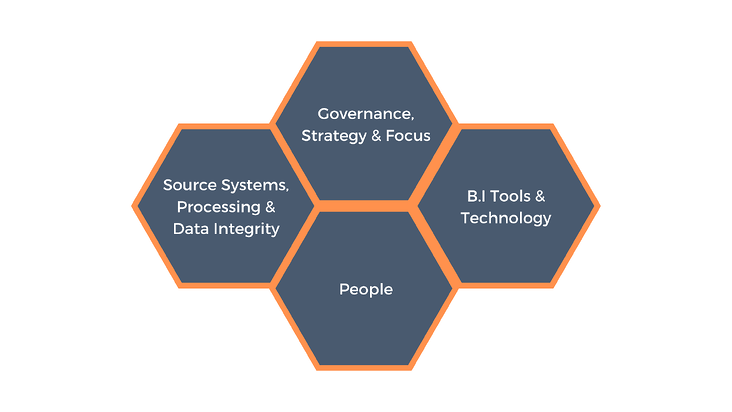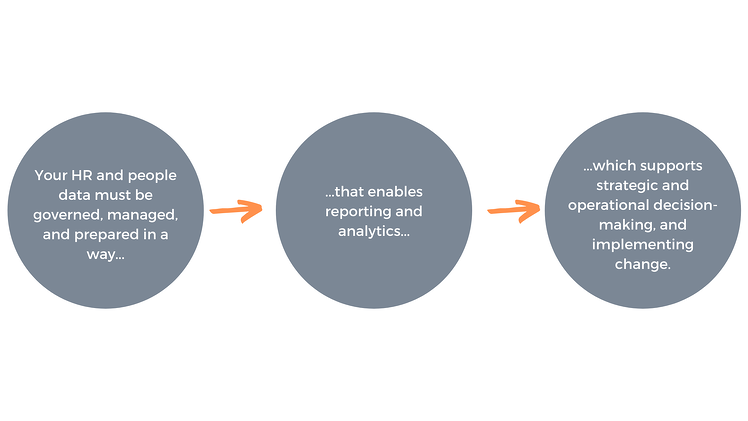Wouldn’t it be great if we could just plunk in an HR analyst, build an HR analytics function, or buy a slick piece of technology, and we’d reap the rewards – capability in analytics, improved business performance, and heightened credibility for HR.
The reality is, it’s not that easy. Purchasing and implementing a tool or hiring an analytics expert doesn’t translate to having the capability. Success in analytics comes when people, processes and technology work together to achieve strategic goals.

Governance, Strategy and Focus
Let’s start with a brief look at Strategy & Focus, and Governance. I say a brief look because this is a BIG topic – and one that deserves more time than we can devote to it in our 5 Minute Friday. For that reason, it’s recommended you read this overview and, for more detail, you can access our Playbook 3 where we go into depth with a case study and templates/worksheets you can use.
For success in analytics, it’s important to have a top-down guide or decision-making framework to help guide and focus your HR reporting and business intelligence efforts on the right stuff.
Your framework should be based in a few simple principles:
- Take a Strategic, Benefits-Driven Approach to Select Your Data-Driven HR (DDHR) Activities
- Engage with Key Stakeholders Throughout to Gain Alignment
- Prioritize Using a Decision-Making Framework
And with the overall objective of:

Let’s take a look at STRATEGY & FOCUS first. This is all about taking action and developing a clear understanding of your key stakeholders and their needs. It involves conducting working sessions, or a series of meetings to accomplish the following objectives:
Step 1.) Understand Your Primary User of HR Information and Define Customer Requirements
Step 2.) Identify your HR Reporting & Analytics Use Cases – Do Three: Help Two: Fix One
Step 3.) Understand Availability, Quality & Cost of Data Collection
Step 4.) Estimate & Articulate Value of Each Use Case
Step 5.) Assess & Map Use Cases to a Decision-Making Framework to Help You Prioritize
Document your findings in the Data Driven HR Planning Sheet.
The sample provided in Playbook 3 is based on the data driven HR needs of a fictitious, yet representative Sales Organization.
Now You Have Your Plan, What’s Next?
You now must work each of your projects with the approach from Playbook 1. Specifically, Revisit Playbook 1, Steps 1-1 through 1-7 – and implement each of these steps for EACH of your projects.
Iterate Where & When Necessary
You may find that a hard requirement may sound great at first conversation, but when you drill into its feasibility, the access to the clean and reliable data needed, and the overall business impact of doing nothing, your “project” or “initiative” may fall well short and off the map entirely.
Part of your job is to continually assess your projects, and iterate based on relevance to your operational and strategic plans, and the business issues and opportunities that you are faced with at that point in time. You should therefore, formally revisit your DDHR scope and approach for each LoB every 6-12 months.
Governance
There are entire books written on this subject alone. While there’s no doubt in my mind it’s critical to adopt solid governance, many people can become stuck in the mud trying to design and implement strict governance far too early. Here are some tips you might find useful:
- Don’t Let Governance Bog You Down
- Book A Monthly Meeting with Key Stakeholders
- Report Status, Confirm Plans, Gain Input, Ask for Help
Here’s the one simple, practical and easily applied approach built around the key ingredients of good governance:
- Identify and ask the company-wide Champion for People Analytics (this could be the Head of HR, Head of HR Operations, Head of Talent Management, etc) to sit on a Steering Committee for People Analytics.
- Ask your senior-most Line of Business client to also attend
- Meet monthly with the following agenda (1 hour):
- Accomplishments This Month & Updates from Your 6 Use Cases
- Cumulative List of Business Impacts delivered through People Analytics to date
- Planned Activities for Next Month
- Help/Resources Needed from Steering Committee
- Open Discussion & Action Items